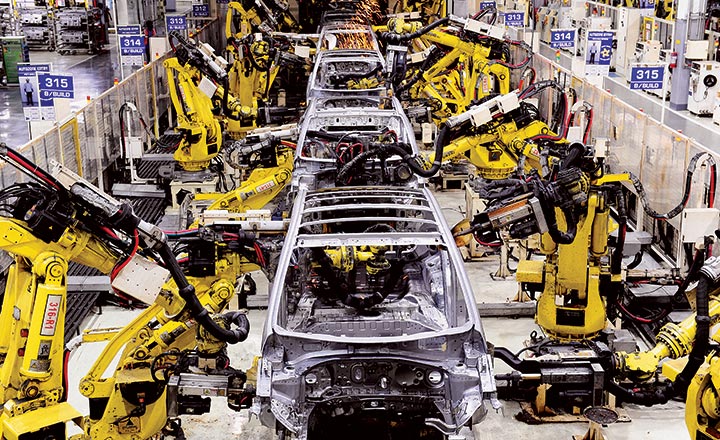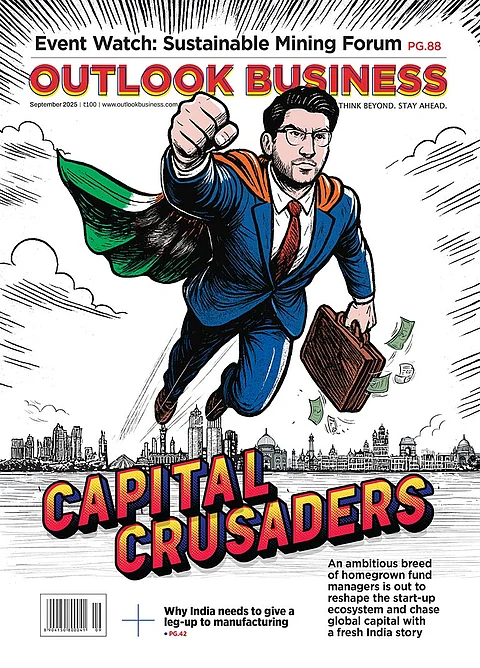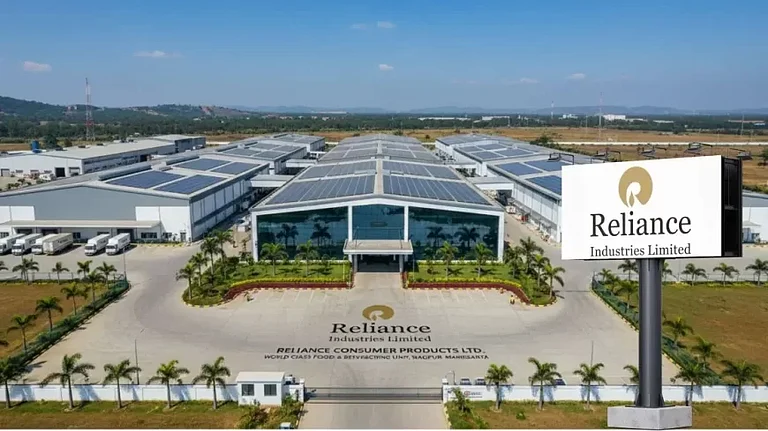"Alien Dreadnought” is a term which is yet to find a mention in the bluebook of manufacturing. But the maverick founder of Tesla has shown the world what he meant when he first alluded to it in 2016.
Keen to meet his target of rolling out 5,000 units a week of the popular Model 3, Elon Musk took upon himself the challenge of creating a fully automated factory — never ever attempted in the history of auto manufacturing. Musk’s audacious dream was to create a factory as a machine that built machines — human intervention would be zero, resembling a futuristic spacecraft manned by extra-terrestrials as shown in science-fiction movies.
While automation and robotics deployment are the highest in the auto industry across the globe, what Musk was aiming for was the impossible — entirely automating the last mile. A typical assembly operation is robotised to varying degrees, with most carmakers deploying workers to transport parts and load them on to machines. Tesla’s ambition was way higher, and it stumbled. Its robots couldn’t deal with different orientations of parts such as nuts and bolts and maneuvering of car frames.
Musk, finally, made an admission. In April 2018, he tweeted: “Yes, excessive automation at Tesla was a mistake. To be precise, my mistake. Humans are underrated.”
Though Musk brought back workers at the Gigafactory, what he has achieved is nothing short of phenomenal — the Fremont factory is 95% automated. The plant has 47 robots that measure 1,900 points in each model to a precision of 0.15 mm of the design specification. Not surprising, therefore, that Musk believes the competitive strength of Tesla, in the long-term, would not to be its car but the factory itself. “We are going to productise the factory… The Model T wasn’t the product. It was the River Rouge. We will have a great product. But the factory is going to be the product that has the long-term sustained competitive advantage,” he said.
Tesla has plans to build 20 energy-efficient Gigafactories around the world, with one already underway in China, but the company does not find a mention in roster of the World Economic Forum (WEF) and McKinsey & Company. This is a list of 16 best factories across the world from over 1,000 manufacturing sites that have implemented industry 4.0 technologies. Described as “lighthouses,” these companies make the cut for comprehensively deploying Industry 4.0 at scale without displacing humans and minding sustainability.
According to the WEF, rather than replacing operators with machines, these factories look to transform work to make it less repetitive, more interesting, diversified and productive. While Tata Steel’s plant in Netherlands is one of the lighthouse factories, putting the disparity in context, Soumyadeep Ganguly, associate partner, McKinsey & Company, says: “Europe boasts nine lighthouse factories, China takes the second spot with five, Saudi Arabia and US have one each, while India nought.” But then India’s manufacturing prowess has been a work in progress for decades now. In fact, the sector’s contribution to GDP has been stagnant at 15% over the past five years. But aspirations are still running high – the aim is to reach the $5 trillion GDP mark by 2025 on the back of 25% contribution from the manufacturing sector.
Labour has always been a pain point for this sector in India. Ganguly says it may come cheap but the productivity is very low. For example, Vietnam’s labour productivity is 4x ours. “This makes the total cost of ownership expensive compared with neighbouring geographies. That has really been the Achilles heel of Indian manufacturing,” he says.
Madhav Vemuri, president, Industrial Automation Division (IAD), ABB India, concurs. “It is a myth that labour is cheap in India,” he says, adding, “getting quality workforce here has been a challenge. Therefore, demand for automation has been rising.”

Sale of industrial robots in India reached a record high of 3,412 new units installed in 2017, reported the International Federation of Robotics (IFR). That is an increase of 30% over the previous year (See: Men of steel). What’s interesting to note is that total number of industrial robot installations in the country has been compounding at an impressive rate – 40%, from 70 in 2000 to over 16,000 now. The manufacturing sector accounts for a lion’s share of the deployment at over 11,000 units. Robots are becoming cheaper to buy too. According to research by ARK Investment Management, the cost of industrial robots is expected to drop by 50-60% to $11,000 a unit by 2025, lower than what most analysts anticipate. The Boston Consulting Group predicts that robots will cost $24,000 a unit by the same year. At those lower prices, ARK is estimating a sale of 3.4 million robot units globally by 2025 – nearly 10x that of 2017.
In the driver’s seat
India’s automotive sector, which makes up 7% of the country’s GDP, has taken to the bots the most. It accounts for 62% of the total installation. The drive for automation intensified during 2012-17 when carmakers cranked up their assembly lines to roll out new models, even as new entrants waded into the market. “The automotive industry will remain the driver of increasing robot installations in India,” states Junji Tsuda, president, IFR, which defines an industrial robot as an automatically controlled, reprogrammable, and multipurpose machine.
The country’s biggest passenger car manufacturer with over 50% market share has deployed over 2,400 robots across its facilities at Gurugram and Manesar, enabling Maruti Suzuki to produce over 1.8 million vehicles a year. PK Roy, executive director (production), says, “Increase in complexity of the vehicles from 1983 to today, in the number of parts, features offered and expectation of quality, has required us to continuously upgrade our manufacturing technology.”

In fact, across industries, especially auto, automation has been deployed for processes that are considered dangerous, dirty or difficult. For example, Maruti has deployed robots to perform hazardous tasks such as welding, where productivity has improved by 20-30%, or intricate operations such as sealing on windshields. “This is particularly handy when new models are introduced, especially in weld and paint shops. It helps in optimising results and improving productivity,” says Roy.
Hyundai Motor India, too, had to wheel in bots at the welding station. The demand had increased working hours and the guns were gaining heft. “Besides longer (work) duration, the need for sophisticated welding also resulted in the (welding) guns getting heavier, and the only way to address the situation was through automation,” explains S Ganesh Mani, director – production, Hyundai Motor. The company’s factory floor has been automated at over 70%, ensuring a car rolls out every 31 seconds. Moreover, automation has enabled the company to capture more than 80% of the data generated, thereby improving operational efficiency. “Over the past three years, our overall defect ratio has drastically fallen to less than 2%,” points out Mani, adding that the company’s 630-plus robots work in “perfect synchrony” with their skilled workforce.
It is important that the two get along and so training is given to the people on how to handle their new colleagues. “Our technicians, at least 700 of them, have been trained abroad in robot programming and die maintenance, which reduces downtime drastically. Hence whenever model or technology changes occur, they are able to adapt very quickly,” elaborates Mani. A 2017 EY report observed that, by 2022, half or more than half of the employees in the Indian automotive sector will be working in roles that have a radically different skill set. The machines are upping the game.
Tata Motors and Ford Motors, too, have deployed the new-age tech. In fact, Tata Motors’ heavy engineering and automation arm, TAL Manufacturing Solutions, has created a niche for itself in the robotics and automation business. Two-wheeler majors Bajaj Auto, TVS and Honda Motorcycle and Scooter are also in the automation race. At Honda’s two-wheeler unit at Bengaluru, where 10 workers were deployed on a single line, machines improved productivity with just three to four workers.
Robot with a difference
If you think about it, it does not make much sense for a manufacturer to hire an acrobat. Unless, cartwheels simply cannot be done without! But Pradeep David, general manager, Universal Robots for South Asia, makes a case for using cobots or collaborative robots in a factory. “They can do more than repetitive tasks, they are flexible like acrobats or even contortionists,” he says.
Cobots are no doubt dexterous, acting like human hands, with each joint that can move 360 degrees clockwise or counterclockwise. These machines are also greener than the big industrial robots. “Cobots use a fraction of the power needed — single phase, 150W for a five kg cobot. Besides, they can be deployed from one application to the next, even within an ongoing production shift,” says David.
Bajaj Auto, which has 50% female workforce, is Universal’s biggest client in India. It has deployed over 100 cobots to take over dull, repetitive tasks in the assembly line, while women engage in the more critical task of quality control.
Even MNCs are warming up to these cold-metal additions. At L’Oreal, they noticed (with worry) that each of their workers were putting themselves at high ergonomic risk by lifting 85,000 kg during eight-hour shifts of moving products for final shipment. A helpful hand from Universal Robots has helped save 30 minutes in every shift.

At smaller facilities, which grapple with errant employees, cobots help delivery quality consistently and sometimes at lesser cost. At the Pune-based SME, Craft and Technik Industries, cobots have helped completely eradicate rejection of the unit’s exported parts. Similarly, the Madurai-based Aurolab has managed to bring down the cost of its manufacturing intraocular lenses (IOLs), an important component for vision restoration, which are imported at exorbitant prices. TAL with its flagship offering, Brabo, which can handle a payload of 2-10 kg and are priced at Rs.500,000-700,000, is looking to upskill MSMEs. CPG Industries, a Satara-based MSME, which manufactures auto components, has deployed three robots on its shop floor. Ashish Gandhi, partner, CPG Industries, in an earlier interaction with Outlook Business had said: “Brabo solved the problem of employee absenteeism. It brought in quality consistency and delivery. A robot can be used on any day including public holidays. What two people could complete in eight hours, a single robot could do in lesser time.” David believes that SMEs’ fondness for cobots is a sign that the adoption rate is zooming. “Cobots are the great equaliser given that they are economically priced. That’s a good starting point to begin the journey towards Industry 4.0.”
While India Inc may not see a lighthouse anytime soon, we are surely headed in that direction.
Industry 4.0
Industry 4.0 needs a change in character in companies, a bit like Tony Stark clipping on the Iron Man suit. They need to embrace key technologies such as autonomous robotics, industrial IoT (internet of things) and cybersecurity. There is definitely intent among a large number of them since it means more efficiency and more productivity, besides meeting safety and sustainability standards.
“Earlier, it was the initial cost that was driving the decision of the management to invest in automation, but that’s no longer the case,” says Vemuri, adding, “They are looking at total cost of ownership and payback. That is positive.” ABB India’s automation business constituted 40% of its order-book of Rs.18 billion as of Q1CY19. The company’s 18% revenue growth during the quarter was driven by 34% revenue hike in the robotics and automation division. “The main trigger for automation is coming out of opex (or operations expenditure) market since there is hardly any greenfield projects or new capacities coming up, barring those like cement,” says Vemuri. The management is expecting a 30% growth in its automation business for CY19, with demand coming from the food and beverages, plastics, tyre, and core sector such as cement.
Automakers have been at the forefront so far. Hyundai Motor India, on average, spends Rs.15 billion annually on plant upgradation including machinery, technology and training. This year, 4.0 will be given priority. They are talking about smart sensors that will measure servomotors and data collection through smart tools, which means that even specially made gloves and pliers will be sending in information to the manager’s cabin. Similarly, Maruti would be installing vision sensors and scanners for quality inspections.
Beyond automotive, even conglomerates such as the Piramal group are leveraging IoT. Piramal Glass, for instance, has deployed Microsoft’s Azure IoT platform. The solution, which could do with a snappier name than its current Real-Time Manufacturing Insights, has been installed on 50 production lines across its plants at Kosamba and Jambusar in Gujarat and Horana in Sri Lanka. “We were clear that we didn’t want to implement new age tech because it was the in-thing, but that it had to have a meaningful impact on business KPIs (key performance indicators),” says Viral Gandhi, group CIO, Piramal Enterprises.
Earlier, business was done the good, old (or tiresome) way. Then, the entire manufacturing process data was captured manually on paper logs, which would go to the operational-excellence team for a post-mortem and analysis. If any hitch was spotted in the production line, the entire batch would get held up. Sometimes, rectifications would have to be carried out on the next batch. “With IoT, we resolve issues on the go,” says Gandhi.Piramal’s target was 1% efficiency improvement, which meant double-digit savings of around Rs.100 million.
What is also working in favour of IoT is its ability to easily get integrated into assembly lines. In case of a traditional manufacturing execution system (MES), aimed at improving productivity, the deployment would entail wiring another heavy machine onto the assembly line. “While MES would have cost Rs.250-300 million, deploying IoT at 30% of that cost also meant the payback is that much faster,” says Gandhi, adding that the last phase of IoT deployment would soon be underway at Piramal Glass’ US facility. “Everything is tied down to RoI,” says Vemuri, adding, “anything which is above 12-18 months payback is a hardsell in today’s market.”
Given that pharma is a regulated business, any changes in the manufacturing process require a slew of approvals. Currently, Piramal is trying an IoT solution at its plant in Pithampur, which will be deployed fully in due course. Interestingly, for its drug-discovery unit at Ahmedabad, it has deployed a robot to guide potential clients during site visits. “Earlier, such visits meant additional costs for the clients and, for us, deploying resources to accompany the client. But with this robot, the controls are given to the client,” says Gandhi.
Still early days
Though there seems to be a strong case for Industry 4.0 and robotics, companies don’t seem ready for the deep dive. According to McKinsey, often their clients don’t get started on Industry 4.0 applications because they lack healthy pragmatism, which involves taking calculated risks. “Despite the successes of early pilots, preparing a business case that justifies data investments can be difficult due to the fact that Industry 4.0 technologies are relatively new, and success cases related to these technologies are still limited,” states a McKinsey report.
Ravi Gilani, founder of Goldratt India and a proponent of Eli Goldratt’s Theory of Constraints (TOC), agrees. He says that the people in charge are neither equipped nor competent enough to make these game-changing decisions. He adds, “Many a time, a C-Suite executive doesn’t understand what’s the weakest link in the chain, so why would they touch it?”
Gilani shares the sentiment expressed by one of his clients: “There are many ways to ruin: the fastest is through gambling, and the surest is through technology.” That may be an extreme viewpoint, but the reality is that India Inc isn’t taking big chances anyway.












 Just one email a week
Just one email a week